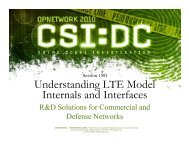Automated Axon Tracking of 3D Confocal Laser Scanning ...
Automated Axon Tracking of 3D Confocal Laser Scanning ...
Automated Axon Tracking of 3D Confocal Laser Scanning ...
You also want an ePaper? Increase the reach of your titles
YUMPU automatically turns print PDFs into web optimized ePapers that Google loves.
successfully track the centerlines <strong>of</strong> such axons in a sequence <strong>of</strong> cross-sectional images in thepresence <strong>of</strong> both such confounding circumstances. The goal <strong>of</strong> the algorithm introduced in thispaper was to reconstruct <strong>3D</strong> medial axes <strong>of</strong> the axons using the stack <strong>of</strong> microscopic images. Theinformation available from the <strong>3D</strong> reconstruction <strong>of</strong> the centerlines <strong>of</strong> the axons helpsneu rologists understand how neurons interact and control muscular retraction in mammals.A significant improvement over seeded watershed algorithm was demonstrated using theguided region growing method. The performance <strong>of</strong> our algorithm was compared with therepulsive snake algorithm and was shown to be more accurate in finding the boundaries <strong>of</strong> theaxonal cross-sections in spite <strong>of</strong> the presence <strong>of</strong> imaging artifacts. The future work wouldinvolve tracking axons in more complex datasets that contain branching patterns and run in thickbundles. Besides tracking the centerlines <strong>of</strong> axons, the proposed algorithm potentially can begeneralized for extracting centerlines <strong>of</strong> other tubular objects in a <strong>3D</strong> volume consisting <strong>of</strong> asequence <strong>of</strong> cross-sectional images.Information Sharing StatementThe sample image stacks and the s<strong>of</strong>tware developed in this paper are available upon request.ACKNOWLEDGEMENTSThe authors would like to thank Mr. H.M. Cai for the help in testing the data sets using theprogram <strong>of</strong> Repulsive Snake Model. They also would like to thank research members <strong>of</strong> the LifeScience Imaging Group <strong>of</strong> the Center for Bioinformatics (CBI), Harvard Center forNeurodegeneration and Repair (HCNR) and Brigham and Women's Hospital, Harvard MedicalSchool, for their technical comments. The research is funded by the HCNR, Harvard MedicalSchool (Wong).35















